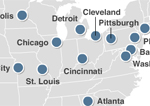America's Big Cities in Volatile Times
QUICK SUMMARY
Note: This research has been updated. For the latest data, see Recovering from Volatile Times.
This report examines how America’s big cities navigated the worst U.S. economic downturn since the Great Depression. It focuses on post-recession revenue as compared with earlier peaks, explores future prospects, and considers cities’ remaining fiscal challenges and their ability to manage future uncertainty while continuing to provide key services to taxpayers.
Overview
City Profiles

The Great Recession created significant fiscal hurdles for the 30 cities at the center of the nation's most populous metropolitan areas. Most of these cities bore the brunt of the downturn later than the federal and state governments and have been slow to recover.
Cities dealt with fiscal strain in a variety of ways: dipping into reserve funds, cutting spending, gaining help from the federal or state government, and increasing revenue from tax and nontax sources. Though these strategies offered short-term solutions, by 2011 many cities still faced challenges, the consequence of declining revenue, reduced spending, shrunken reserves, and rising pension and retiree health care costs.
Property tax collections can be slow to respond to economic swings. They delayed the early effects of the Great Recession for most of these cities but began to drop in 2010. The fiscal effects of this decline were compounded by increasingly unpredictable aid from state and federal governments that were dealing with their own budgetary constraints.
Researchers from Pew standardized data from the Comprehensive Annual Financial Reports for all 30 cities from 2007 through 2011, the latest year for which complete data were available, and adjusted for inflation to facilitate comparison across the years. They then examined key elements of each city's fiscal conditions, including revenue, expenditures, reserves, and long-term obligations.
Although each city had its own distinct experience, examining all 30 revealed several notable findings, including:
- The 30 cities felt the recession's fiscal effects late: Most hit their lowest revenue in 2010 or 2011, a year or more after the end of the downturn and the low point in revenue for state governments in 2009.
- By 2011, revenue had rebounded to or above previous peak levels in less than one-third of the cities studied. But even those improvements were tenuous because revenue increases in many of these cities were heavily driven by aid from other governments, not by growth in cities' own revenue streams.
- More than two-thirds of the cities had not recovered to their previous revenue peak by 2011.
- Fluctuations in aid between 2007 and 2011 from the federal and state governments—sources that city policymakers do not control—were the leading factor in 14 cities' revenue declines and rebounds.
- Declines in smaller revenue sources—such as income from investments or from the sale or lease of assets, such as parking meters or facilities—played an outsized role in driving budget shortfalls in most cities.
- Property tax collections remained relatively robust until 2010 and 2011. Further projected declines of this key revenue source suggest that cities may face new challenges in coming years.
Interactive: Fiscal Condition of American Cities

As cities look ahead, ongoing fiscal constraints at the state and federal levels could further diminish aid to local governments and add to an already shaky fiscal picture. Cities' unfunded retirement obligations put even more long-term pressure on their finances.






